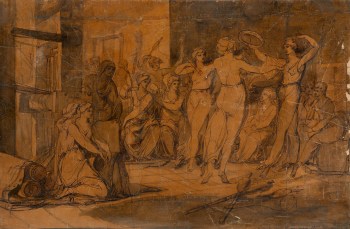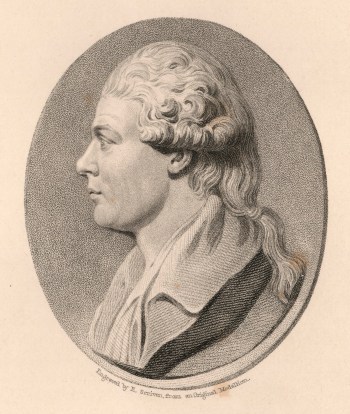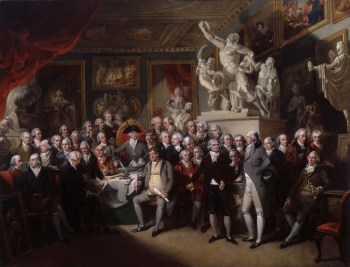James Barry RA (1741 - 1806)
RA Collection: People and Organisations
James Barry was raised in Cork, Ireland, and moved to Dublin at the age of twenty-two. There his talent was quickly acknowledged: his early painting The Baptism of the King of Cashel by St Patrick was purchased for the Irish House of Commons and he attracted the support of the politician and writer Edmund Burke. Burke arranged for Barry to work for the painter and architect James ‘Athenian’ Stuart in London and then financed Barry’s lengthy continental tour (1765-70), most of which was spent in Rome alongside artists including Joseph Nollekens and Alexander Runciman.
Barry’s experience in Rome helped him to formulate his goal as an artist: to revive the principles of classical art and in doing so to reform modern culture. The tension between these lofty artistic and civic ideals and the structure of the Georgian art world was to remain problematic throughout his career. This situation was further complicated by Barry’s identity as a Roman Catholic with close ties to political radicals.
The years following his return to London were the most productive of Barry’s career. He was embraced by the Royal Academy, where he exhibited numerous pictures between 1771 and 1776. Barry became an Associate in 1772 and a full Member the following year. Barry then began work on a series of six pictures for the Great Room of the Society for the Encouragement of Arts, Manufactures, and Commerce, in London, depicting The Progress of Human Culture (1777-84). This commission resulted in Barry’s masterpiece – which can still be seen in situ – but required him to live austerely for several years at a time when leading portraitists were becoming wealthy from their work. Other ambitious schemes, such as one to illustrate John Milton’s epic poem Paradise Lost, came to nothing.
In 1782 Barry was elected as Professor of Painting at the RA, and he used his lectures, together with a number of publications, to set out his vision of the Grand Style in history painting. He also used his lectures and writings to criticise the policies of the Academy, and his relationship with the RA deteriorated to the extent that Barry claimed that fellow Academicians instigated the burglary of his house in 1794. Eventually, in 1799, Barry became the first of only two Academicians ever to have been expelled. Barry’s Diploma work Medea making her Incantation after the Murder of her Children was probably returned to Barry at this time, although its present whereabouts are unknown.
Barry’s output was small, in the latter part of his life he completed only four major history paintings and these did not sell in his lifetime. In his final years the artist was impoverished and living in squalid conditions, alienated by the art world and his attempt to establish history painting in Britain having foundered. Nevertheless, his artistic achievements were held in high regard and he was buried in St. Paul’s Cathedral next to the first President of the Royal Academy, Sir Joshua Reynolds.
Profile
Born: 11 October 1741 in Cork
Died: 22 February 1806
Nationality: Irish
Elected ARA: 2 November 1772
Elected RA: 9 February 1773
Professor of Painting: 1782 - 1799
Expelled: 15 Apr 1799
Gender: Male
Preferred media: Painting, Printmaking, and Etching
Works by James Barry in the RA Collection
9 results
-
![James Barry RA, Ticket of admission for a performance of Horace's 'Carmen Seculare']()
James Barry RA
Ticket of admission for a performance of Horace's 'Carmen Seculare', 1779
Etching
-
![James Barry RA, Satan at the Abode of Chaos and Old Night]()
James Barry RA
Satan at the Abode of Chaos and Old Night, c. 1792-95
Pen and brown and black ink with grey wash over black chalk on laid paper
-
![James Barry RA, Male nude sitting on a rock]()
James Barry RA
Male nude sitting on a rock, c. 1790s?
Pen and ink over black chalk on cream laid paper
-
![James Barry RA, A standing male nude holding a palm, possibly for 'Crowning the Victors at Olympia']()
James Barry RA
A standing male nude holding a palm, possibly for 'Crowning the Victors at Olympia', c. 1780
Pen and ink over black chalk with white chalk highlights on brown laid paper
-
![James Barry RA, Bacchanale]()
James Barry RA
Bacchanale, by 1806
Pencil, pen and ink on cream laid paper
-
![James Barry RA, Study for 'George III giving the Bill to the Judges']()
James Barry RA
Study for 'George III giving the Bill to the Judges', ca. 1784-8
Pencil, pen and ink on cream laid paper
-
![James Barry RA, Two studies of a bust of Minerva or Pallas Athena]()
James Barry RA
Two studies of a bust of Minerva or Pallas Athena, c. 1784 - 1806
Pen and ink and wash over red chalk on cream laid paper
-
![James Barry RA, A bust of Pericles and a bust of Minerva viewed in profile]()
James Barry RA
A bust of Pericles and a bust of Minerva viewed in profile, between 1782 and 1806
Pen and ink and red chalk on cream laid paper
-
![James Barry RA, Eastern Patriarch]()
James Barry RA
Eastern Patriarch
Pen lithograph on laid paper
Works after James Barry in the RA Collection
1 results
Works associated with James Barry in the RA Collection
9 results
-
![James Jefferys and James Barry RA, A group of women weavers leave their work to dance and make music]()
Attributed to James Jefferys and Formerly attributed to James Barry RA
A group of women weavers leave their work to dance and make music, 1777
Pen and brown ink with grey wash on laid paper
-
![James Jefferys and James Barry RA, Poet reciting to a crowd seated and standing around a tree]()
Attributed to James Jefferys and Formerly attributed to James Barry RA
Poet reciting to a crowd seated and standing around a tree, 1770s
Pen and brown ink with wash on laid (?) paper
-
![James Jefferys and James Barry RA, Homer Reciting his Poetry to the Greeks]()
Attributed to James Jefferys and Formerly attributed to James Barry RA
Homer Reciting his Poetry to the Greeks, February 1777
Pen and brown ink with grey wash on laid paper
-
![James Jefferys and James Barry RA, The Murder of Caesar]()
Attributed to James Jefferys and Formerly attributed to James Barry RA
The Murder of Caesar, 1770s?
Pen and brown ink with brown wash and white oil paint (?) on thin laid paper
-
![James Jefferys and James Barry RA, The Body of Lucretia Exposed to the Romans]()
Attributed to James Jefferys and Formerly attributed to James Barry RA
The Body of Lucretia Exposed to the Romans, 1770s?
Pen and brown ink with grey wash on thin laid paper
-
![Edward Scriven, Profile portrait of James Barry]()
Edward Scriven
Profile portrait of James Barry
Stipple engraving
-
![G.M. Brighty, Portrait of James Barry]()
After G.M. Brighty
Portrait of James Barry, ca. 1815
Stipple engraving
-
![George Dance RA, Portrait of James Barry, R.A.]()
George Dance RA
Portrait of James Barry, R.A., 2 April 1793
Pencil with black and pink chalks on cream wove paper
-
![Henry Singleton, The Royal Academicians in General Assembly]()
Henry Singleton
The Royal Academicians in General Assembly, 1795
Oil on canvas
Associated books
12 results
-
James Barry RA,
A Letter To The Dilettanti Society, Respecting The Obtention of certain Matters essentially necessary for the Improvement of Public Taste, and for accomplishing the original Views of the Royal Academy Of Great-Britain. By James Barry, Esq. R.A. Professor Of Painting To The Royal Academy. - The Second Edition. - With An Appendix, Respecting the Matters lately agitated between the Academy and the Professor of Painting. - - London:: [1799]
07/3098
-
James Barry RA, source artist, engraver
A Series Of Etchings By James Barry, Esq. From His Original And Justly Celebrated Paintings, In The Great Room Of The Society Of Arts, Manufactures, And Commerce, Adelphi. - London:: 1808.
05/326
-
James Barry RA
The Works Of James Barry, Esq. Historical Painter; Formerly Professor Of Painting At The Royal-Academy; Member Of The Clementine Academy At Bologna, &c. Containing, His Correspondence From France And Italy With Mr. Burke - His Lectures On Painting Delivered At The Royal-Academy - Observations On Different Works Of Art In Italy And France - Critical Remarks On The Principal Paintings Of The Orleans Gallery - Essay On The Subject Of Pandora; (Now First Published From Manuscripts, And Illustrated By Engravings From Sketches, Left By The Author.) And His Inquiry Into The Causes Which Have Obstructed The Progress Of The Fine Arts In England - His Account Of The Paintings At The Adelphi - And Letter To The Dilettanti Society. To Which Is Prefixed, Some Account Of The Life And Writings Of The Author. In Two Volumes. Vol. I. (II.) - London:: 1809.
04/3316
-
James Barry RA
A Letter To The Dilettanti Society, Respecting The Obtention of certain Matters essentially necessary for the Improvement of Public Taste, and for accomplishing the original Views of the Royal Academy Of Great-Britain. / By James Barry, Esq. R.A. Professor Of Painting To The Royal Academy. - London: [1798]
23/423
Associated archives
35 results
-
[copy?] Note by G.R., on the reverse of an official [Royal Academy] document signed by Jno. Richards
[1799]
Item LAW/5/83
-
Thos. Lawrence, to [Joseph Farington]
9 Feb 1812
Item LAW/2/10
-
[Thomas Lawrence], to [Joseph Farington]
[Sep 1810]
Item LAW/1/256
-
[copy] Thomas Lawrence to [Lucy Lawrence]
1788
Item LAW/1/13


















